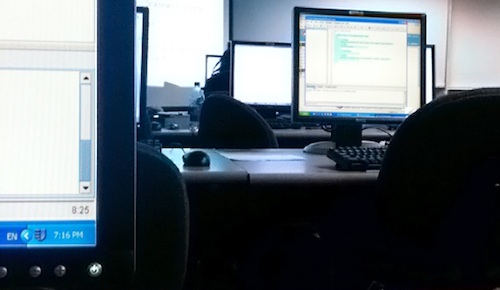
A new tax on imported monitors has the computer industry increasingly incensed and they want action from authorities to remedy the situation, which they say is harming the technology sector.
In April, a 7% ad valorem tax, which previously only applied to imported television sets and which was scrapped in 2004, was reintroduced on computer monitors, because some companies were importing them without TV components and adding these locally to avoid the tax.
The result is more expensive monitors in an industry that’s meant to be trying to make its products as cheap as possible to get more South Africans online.
The SA Revenue Service (Sars) says the tax was instituted to protect SA’s TV manufacturing industry. But this industry has all but disappeared in recent years. The tax is only meant to apply to monitors larger than 20,8 inches, but as most monitors are now larger than this, it affects most sales.
Jed Michaletos, a director at Deloitte, says neither lawmakers nor retailers are happy about the tax and its implications. “The tariff structure is flawed and always has been,” he says. “Computer components are meant to be exempt from duties. Originally, the rule was that any display bigger than 45cm got taxed, regardless of its intended purpose. But now that means graphic designers, the medical industry, and others who shouldn’t have to pay duties, are being forced to.”
Michaletos says the part of the problem is the speed with which the technology industry moves. He argues that legislators can’t keep up and this results in things like the monitor taxation that requires frequent amendments to remain relevant and to continue to achieve its stated aims.
He says specialist monitors, such as those for the medical industry, don’t have local equivalents, and so should be exempt from taxation because there is no local industry to protect. “It’s just more money for Sars really,” Michaletos says.
David Kan, CEO at computer company Mustek, says that it’s important to note that the actual taxes applied come to 34,8% rather than just the ad valorem tax of 7%. “There is a 25% import duty and ad valorem is levied on top of this.” In total, taxes on monitors amounts to 34,8% of the total cost.

“It’s also important to remember that the form factor of monitors has changed in recent years from 4:3 to 16:10 to 16:9, so most monitors now exceed the 45cm or 20,8-inch limit,” says Kan.
He says when he approached national treasury about the motivations for the tax he was told that the levies were intended to protect the local manufacturing industry. “But if you look at how long the TV industry has been protected by these duties, and how there isn’t really a local manufacturing industry left, you have to ask why they’re still protecting it.”
Kan says it’s a misnomer to speak of the SA TV manufacturing industry. “It’s more accurate to talk about the local assembly industry as no components are actually made in SA any more. There’s just an industry of people with screwdrivers putting TVs together.”
The result, says Kan, is an industry that has to import parts and then assemble them, resulting in more unnecessary packaging and greater transport costs. “When you import a whole TV you only need one set of packaging, as opposed to packaging for each part. Also, you can ship more whole TVs in a single consignment than parts of TVs. Why are we protecting a local industry that doesn’t really do anything? They should remove the tax entirely. If they want to argue that assembly is creating local jobs, then why not protect the computer industry that really does create jobs?”
Kan wants the computer industry to lobby for the tax to be scrapped because the agenda behind it is misplaced, saying the only benefits of the tax are to Sars’s coffers and that “consumers suffer the most because of it”.
“If you visit Samsung’s assembly plant in East London, you can see how few employees there are,” he says. “It’s a screwdriver industry. Components arrive readymade and are literally just put together. Why is government protecting this sort of industry? If SA was actually making components it would be understandable, but we’re not.”

Bronwyn Hume, head of marketing at LG Electronics in SA, says the Korean company has had no choice but to adjust its prices in line with the new tax.
“We’ve tried to manage it effectively and absorb what we could, but it has resulted in substantial increases in prices for consumers,” she says.
Kevan Jones, executive director at the SA Communication Industries Association (Sacia), an industry body, echoes Kan’s views and says the tax is “protecting an industry that to a large extent no longer exists”.
“There are no local manufacturers of professional-grade displays and there are unlikely to be, so audio-visual professionals are being charged to protect an industry that isn’t there,” Jones says.
He says large-format displays, like those used in digital signage, the medical industry and in broadcasting are all specialist products that cost more than consumer alternatives to start with. “Those prices have increased even further.”
In the process, says Jones, government has become its own worst enemy because it is the largest user of professional displays. “Many products are now out of the reach of the commercial market.”
He says the professional devices were never going to be used as alternatives to consumer products anyway, and that this was what the tax was intended to prevent. Many companies, such as those providing video post-production services, are buying less equipment to offset the increased costs.
Sacia has been tasked with creating a lobby group that will engage with the industry and Sars and explore opportunities to encourage them to reduce duties and ad valorem taxes, he adds. “We’ve asked Deloitte to conduct an initial survey into this issue. The problem is, many vendors active in the market believe that government is inflexible and will not be swayed by any arguments and they are therefore reluctant to invest funds in engaging in a discourse unless there’s a guaranteed outcome, which of course there isn’t.”
Jones says monitors that can be shown to be for computer use alone are exempt from the tax. All-in-one computer products like the Apple iMac fall into this category. “Those monitors brought in as part of a computer package are exempt, but those that are brought in independently aren’t.” Because some companies manufacture monitors only, rather than integrated PCs, there is no workaround.
“The wording of the legislation is poor,” Jones says. “It talks about it applying to screens over 20,8 inches and while the global standard is to measure diagonally, here they mean the longest side. They’re applying a measurement criterion that is just irrelevant. The law also talks about being applicable to screens up to a maximum size of 4x3m, but no monitors are built to that size. I suspect they looked at 4:3 as an aspect ratio and just tacked on metres.”
He says the monitor tax has been implemented without consultation with relevant industry players and, as such is “just fraud really”, adding that it’s important that vendors provide funding to assess and fight the tax for the long-term good of the industry rather than simply accepting it. — Craig Wilson, TechCentral
Credits: Effekt! (top image); TotalAldo (bottom image)
- Subscribe to our free daily newsletter
- Follow us on Twitter or on Facebook




